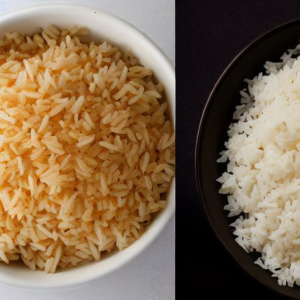Rice is a staple food consumed by millions of people worldwide. As an important source of energy, it is essential to understand the glycemic index (GI) of different rice varieties to make informed dietary choices. The GI measures how quickly carbohydrates in food are broken down and absorbed, affecting blood sugar levels. We’re going to show the GI values of 10 diverse rice types, highlighting their health benefits. Additionally, we will present low to moderate GI alternatives to rice, such as couscous and cauliflower rice, which are great alternatives that offer a ton of flavor and a lower Glycemic impact.
 Glycemic Index of 10 Rice Varieties:
Glycemic Index of 10 Rice Varieties:
-
Basmati Rice: Basmati rice, known for its aromatic flavor and long grains, has a GI value ranging from 50 to 58, classifying it as a low-GI food. Its slower digestion and absorption help maintain stable blood sugar levels, making it a favorable choice for individuals concerned about glycemic control.
-
Jasmine Rice: Jasmine rice, popular for its delicate fragrance and moist texture, typically possesses a moderate GI score of around 68. Although higher than Basmati rice, it still falls within the moderate range. Combining it with protein and fiber-rich foods can further minimize the glycemic response.
-
Arborio Rice: Arborio rice, commonly used in risotto dishes, has a higher GI value, averaging around 69. Its increased starch content leads to quicker carbohydrate absorption, potentially causing a more substantial spike in blood sugar levels. However, consuming it alongside other low-GI foods can help balance its impact.
-
Brown Rice: Brown rice, an unrefined whole grain, boasts numerous health benefits due to its high fiber content. It typically has a GI value of 50 to 55, placing it in the low-GI category. The fiber slows down digestion, contributing to improved glycemic control and increased satiety.
-
White Rice: White rice, the most commonly consumed rice variety, generally has a higher GI value compared to brown rice, ranging from 70 to 73. During the refining process, the bran and germ layers are removed, resulting in reduced fiber content. Combining it with other low-GI foods can help mitigate its glycemic impact.
-
Black Rice: Black rice, also known as forbidden rice, is a whole grain with a deep purple color. It offers a variety of antioxidants and nutrients. With a GI value of around 42 to 45, it falls within the low-GI range. Incorporating black rice into meals promotes stable blood sugar levels and provides additional health benefits.
-
Red Rice: Red rice, often used in traditional Asian cuisine, carries a moderate GI score of approximately 55 to 60. It contains more fiber and nutrients compared to white rice due to its intact bran layer. This additional fiber aids in slowing down digestion and moderating blood sugar spikes.
-
Wild Rice: Wild rice, although not a true rice grain but a type of aquatic grass seed, offers a GI value of around 45 to 55, classifying it as low to moderate GI. Its high fiber content contributes to slower digestion, improved glycemic control, and enhanced satiety.
-
Sticky Rice: Sticky rice, commonly found in Southeast Asian cuisine, has a higher GI value, averaging around 78. Its sticky texture and higher amylopectin content contribute to faster digestion and absorption of carbohydrates. Balancing it with other low-GI foods is recommended for better glycemic control.
-
Parboiled Rice: Parboiled rice undergoes a special processing technique that involves partially boiling the grains in the husk. It typically possesses a moderate GI value of around 65 to 75. This process alters the starch structure, resulting in slower carbohydrate digestion compared to white rice.
Low to Moderate GI Alternatives:
-
Couscous: Couscous, made from semolina wheat, has a moderate GI value ranging from 65 to 70. Although not a rice substitute, it offers a variety of nutrients and can be an alternative for those looking for lower-GI options.
-
Cauliflower Rice: Cauliflower rice, a versatile low-carb alternative made by finely chopping cauliflower, boasts an extremely low GI value of around 15. It provides a great substitute for rice in various dishes, particularly for individuals following low-GI or low-carbohydrate diets.
Comparative Table of Glycemic Index Scores:
| Rice Variety | Glycemic Index (GI) |
|---|---|
| Basmati Rice | 50-58 (Low) |
| Jasmine Rice | ~68 (Moderate) |
| Arborio Rice | ~69 (Moderate) |
| Brown Rice | 50-55 (Low) |
| White Rice | 70-73 (High) |
| Black Rice | 42-45 (Low) |
| Red Rice | 55-60 (Moderate) |
| Wild Rice | 45-55 (Low-Moderate) |
| Sticky Rice | ~78 (High) |
| Parboiled Rice | 65-75 (Moderate) |
Understanding the glycemic index of different rice varieties allows individuals to make informed choices based on their dietary needs and goals. Opting for low to moderate GI rice varieties, such as Basmati, brown, black, or wild rice, can support better glycemic control. Additionally, alternatives like couscous and cauliflower rice offer low to moderate GI options that provide diversity in meals while contributing to healthier blood sugar management. Remember to combine rice with protein, healthy fats, and fiber-rich foods for better glycemic balance and overall well-being.
